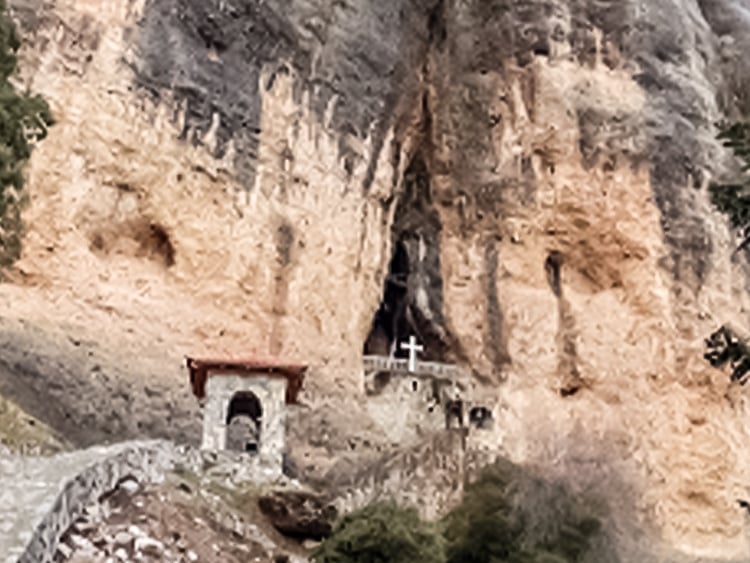


Distance from hotel: 43,7Km/36mins driving
In a pine-covered location, 3 km away from Chiliomodi, is the Monastery of Faneromeni, which is dedicated to the Assumption of the Virgin Mary. Initially it was located further away, about 4 km from the current monastery, in a position with excellent view of the surrounding area and views to the Acrocorinth. From the old monastery the 13th century catholic is preserved with beautiful but worn frescoes, and the half-ruined buildings of the cells. In the revolution of 1821 the monastery had a significant material and spiritual contribution, it was a refuge of the civilian population of the area, and a place of prayer for great chiefs, such as Kolokotronis and Nikitaras. In 1854 the monastery was severely damaged by an earthquake, and in 1896 the fraternity of the monks moved to the new monastery, which had been founded in the 16th century and until then was part of the old one. At that time the iconostasis of the first temple and the miraculous icon of Panagia Vrefokratousa were moved to their current location. In 1949 the monastery was renovated and turned into a convent. The catholic church is a cruciform church with a dome that rests on two columns and dates back to 1896, as it was then renovated, with the transfer of the monastery. Inside, the ornate old wood-carved iconostasis of the 17th century is preserved, which is decorated with representations from the Old and New Testaments, as well as the icon of the Virgin Faneromeni, which is considered the work of the evangelist Luke. The monastery has relics and holy relics, among which is the chariot of St. Sophronius, patriarch of Jerusalem. Outside the monastery there is a small church of Agia Marina, which dates back to the 16th century and has been painted by the great painter of the time, Dimitrios Kakkavas.
Distance from hotel: 36,9Km/45mins driving
Situated at a 650m – 700m altitude, the holy convent challenges the faithful Christians to go on a pilgrimage, which requires driving a 14-kilometre distance and successfully walking up the 180 steep steps before entrance. Osios Patapios came from Thebes, Egypt. He cloistered at the Egyptian desert during the 4th or 5th century a.d. At that period, he became so popular with Christians, that crowds of believers passed by to meet him. In 1904, during excavation procedures by the cave, the Osios Patapios’s relics where accidentally found. They were intact! A few years later, the Osios Patapios Monastery was built.
Distance from hotel: 84,5Km/72mins driving
The Monastery was established in the 4th century by two monks. It takes its name from the rocky complex of Mount Chelmos where it is built. It suffered many disasters throughout the history. Today, the renovated building of the Monastery, stick to the rock, take a breath even the most nonchalant visitor. The main building of the Monastery is decorated with frescoes from 17th century, marble floor decorations, a wooden iconostasis and famous wine cellars. Visitors of the Monastery can feel the inconsequentiality of everyday life, overwhelmed by the majestic atmosphere of the rocky cave.



Distance from hotel: 99,5Km/90mins driving
The famous Monastery of Agia Lavra, which is dedicated to the Assumption of the Virgin Mary, is umbilically connected with the beginning of the revolution of 1821 and the swearing in of the first fighters and the Kalavryta revolutionaries. “Freedom or Death” is sworn in at the Beautiful Gate of the Church of the Holy Lavra and the glorious banner of the struggle is raised here to wave for centuries along with the echo of the historical dilemma. Here the Greek Church represents the nation, ensuring and embodying the uninterrupted historical continuity of Hellenism. Church and Nation will face looting, destruction and losses fighting for faith and homeland. Thus, the Monastery is not only a pan-Hellenic national-religious pilgrimage of the first magnitude but also one of the oldest monasteries of Hellenism.
Distance from hotel: 78,5Km/86mins driving
The temple, in the cave-slit of a rock, of Zoodochos Pigi or Faneromeni of Panagia tou Vrachos, as the Feneates call it, is located west of the village of Tarsos in the prefecture of Corinth. Tradition says that the church of Panagia on the rock of Tarsus was founded as a fulfillment of a vow by a woman from the village of Tarsos, who was miraculously saved during the conquest of Byzantine Tarsus by Mohammed II the Conqueror in 1458. According to others, some women of Tarsus jumped from the rock alone so as not to become slaves of the Turks and so the rock of Tarsus became a second “Zalongos” which is now the temple of the Virgin. A young mother with baby in her arms to grieve her child. But the Turks were not moved at all and threw her on the rock with the baby. She, however, invoked the help of the Virgin Mary and was found at the base of each rock at 100 meters, safe and sound. Out of gratitude for her salvation, this woman formed the slit of the rock in a temple, putting some images. The church today is decorated with remarkable icons, such as the Virgin Mary, Christ, the Assumption of the Virgin, which date back to 150 years and are works of the hagiographer Asimakis Skaltzas. There is also the portable icon of the Virgin holding the baby for 200 years and more. This image has dimensions 37X29 and is painted on one-piece chipped wood. It depicts the Virgin Mary holding the divine infant from the waist up, supporting it with her right hand. A stone staircase reaches the pronaos, then on the third level is the sanctuary inside which springs a spring with holy water. To the left of the temple there is a very low entrance that leads to the sink.
Distance from hotel: 73,7Km/88mins driving
The first monastery built was the Old Monastery in the 14th century and was located on Lake Doxa. However, due to the floods of the lake, the new Monastery was abandoned and built in a higher and safer place. The Monastery was built in 1693 and renovated in 1753 due to fire. Inside the church dominates the majestic chandelier and the carved wooden iconostasis which is decorated with representations from the Old and New Testaments. On the other side of the church there are admirable murals and a small wooden staircase leads to the “Hidden School”.

Distance from hotel: 147Km/120mins driving
Agia Theodora Vasta is a small Byzantine church and has 17 holly and maple trees growing from its roof. Most of them are taller than 30 metres and it’s phenomenal as there is only one root about the thickness of an arm that is visible beside the entrance. Even more amazing is its tiny barrel vaulted interior where, except for one wispy bit of green there is not one sign of the trees or roots. Another fascinating fact about the location is that a river runs beneath this church and irrigates the trees. Agia Theodora’s church has become a popular pilgrimage site for Greeks and her feast day is today, September 11, where thousands and thousands of people from all across Greece will travel here to pray. Agia Theodora Vasta is known to have performed many miracles for those who pray to her. The Holy Virgin Martyr Theodora of Vasta grew up in a village where the family would send the sons to fight in the army against the enemy. Having no boys in the family, Theodora decided to join the army to save her father from having to do so. Disguising herself as the soldier Theodore, she soon became one of the most valiant and brave soldiers. A woman soon developed lustful feelings for “Theodore” and claimed that he had impregnated her. Theodora was commanded to either marry the woman or be condemned to death. Doing nothing to prove her innocence (as easy as this would be) Theodora placed her hope in God.
Being condemned to death, before her execution, she prayed, “Let my body become a church, my blood a river, and my hair the trees.” On the spot where she was martyred, a spring gushed forth which flooded to become a river which still exists today. The faithful built a small church over her spot of martyrdom where soon 17 enormous trees (some weighing over 1 tonne) began growing on the roof of the church. The 17 trees symbolised her age when she was martyred. Countless scientific studies have taken place to uncover the mystery of 1) how the small church continues to support such enormous trees and 2) how these trees grew and continue to survive with no evidence of any root system reaching the ground. Scientists have taken x-rays of the church walls, which show no signs of any root formation anywhere. High frequency geo-radar also indicated that the roots are all hair thin and somehow thread their way inside the walls of the church to get their nourishment from the spring underneath it – quite a miracle all in itself.
